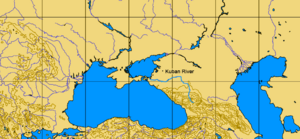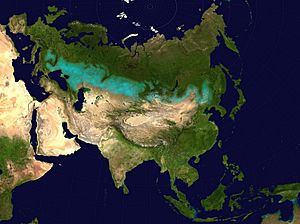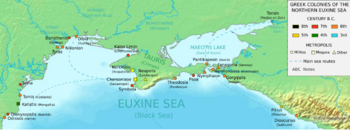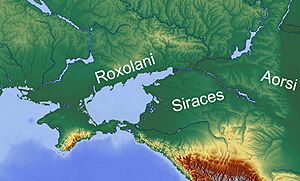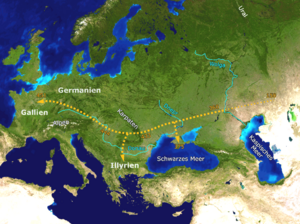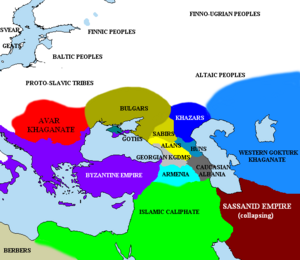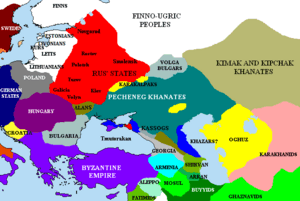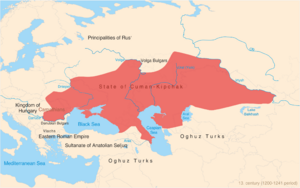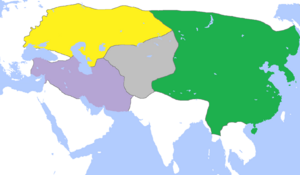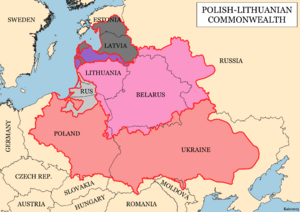History of the western steppe facts for kids
This article explores the exciting History of the Western Steppe. This is the western part of the vast Eurasian steppe, which means the huge grasslands found in modern-day Ukraine and southern Russia. Think of it as a summary and guide to more detailed stories. It's a companion to the histories of the central and eastern parts of the steppe. The dates mentioned are usually close guesses, as it's hard to know exact start and end times for these ancient events.
Contents
What is the Western Steppe Like?
This area is shaped a bit like a triangle. On one side, forests meet the grasslands. This line starts near where the Danube River flows into the Black Sea and stretches northeast towards a city called Kazan. Then, it turns south along the western side of the Ural Mountains. This wasn't a sharp line, but more like a wide band where forests and grasslands mixed. Today, much of it has been turned into farmland.
The southern border follows the Black Sea coast, then continues along the north side of the Caucasus Mountains, reaching the Caspian Sea. From the Caspian, it goes north towards the Urals, connecting this area to the central steppe. The Sea of Azov sticks out northeast, making the Black Sea-Caspian Steppe almost like a peninsula. The western part is sometimes called the Kuban region, named after the Kuban River. The Crimean peninsula reaches into the Black Sea, acting as a bridge between the steppe and powerful empires like the Byzantine and Ottoman. Far to the west, the Hungarian plain is like a grassland island, separated by mountains.
Most of this region is great for farming, except for the dry, semi-desert areas west and north of the Caspian Sea. Important trade routes ran north to south along the Volga River and Dnieper River. The Don River was also used, but less often.
Understanding Steppe History
For reasons we don't fully understand, most groups of people on the steppe moved from east to west. Also, around 500 AD, the original Iranian languages spoken here were replaced by Turkic languages. Unlike the central and eastern steppes, the western steppe is now mostly used for farming.
Historians learn about steppe history from old writings by nearby civilizations and from things archaeologists dig up. The many groups of people mentioned were often just one clan or tribe that became powerful enough to control their neighbors. It's hard to know if they were all from the same family or if some movements were truly whole groups of people migrating. Borders changed often and weren't well-recorded.
Early Times: Before Written Records
Many experts believe that the Indo-European languages, which include English, Spanish, and Hindi, first appeared on the western steppe. Before about 1000 BC, Iranian languages were spoken across the western and central steppe. We don't fully understand how pastoral nomadism (people moving with their animals) began. The first reports of warriors riding horses and shooting arrows (mounted archery) come from the Cimerians around 700 BC.
Archaeologists have found evidence of several ancient cultures here:
- The Tripolye culture (around 4000 BC) on the western edge.
- The Sredny Stog culture (around 4000 BC) near the Dnieper River.
- The Yamna culture (around 3000 BC), possibly linked to Indo-European speakers.
- The Srubna culture (around 1500 BC), connected to the Andronovo culture further east.
The Iranian Period (around 700 BC - 450 AD)
- Scythians (around 700 BC - 300 BC): The ancient Greeks called most people living north of the Black Sea "Scythians". The Persians called similar people in the central steppe "Sakas". Both groups spoke Iranian languages.
- Greeks (around 650 BC - 370 AD): Starting in the 7th century BC, Greeks set up colonies around the Black Sea. They traded grain and slaves, a pattern that continued for centuries. Many of these colonies became part of the Bosporian Kingdom.
- Cimerians (around 700 BC): Ancient writers say the Scythians pushed the Cimerians across the Caucasus Mountains. The Cimerians then raided other lands.
- Scythians Proper (around 650 BC - 300 BC): These Scythians might have started in the Kuban region and moved northwest. Around 513 BC, the Persian king Darius I tried to invade Scythia but couldn't catch them. Some Scythians later had a small kingdom in the Crimean peninsula.
- Sarmatians (around 300 BC - 375 AD): The Sarmatians took over from the Scythians and ruled the steppe until the Huns defeated them. They came from east of the Scythians and spoke a similar language. They were known for their heavy cavalry (heavily armored horsemen) and possibly had female warriors, which might have inspired the Greek stories of the Amazons.
* The Sarmatians included several groups like the Alans, Iazyges, Roxolani, and Siraces. The Alans traveled far west, joining Germanic tribes and ending up in places like France and Spain. Some Alans stayed in the Caucasus Mountains and became the modern Ossetians.
- Goths (around 250 AD - 375 AD): The Ostrogoths crossed what is now Poland and took control of the western part of the steppe. After they were defeated, some Goths continued to live in Crimea.
- Huns (around 350 AD - 454 AD): The Huns, a group from central Asia, crossed the Volga and Don rivers. They absorbed the Alans, pushed the Goths into the Roman Empire, and raided Roman lands before their confederation broke apart.
- A Mysterious Century (around 450 AD - 550 AD): This period isn't well-documented, so we don't know much about what happened on the steppe.
The Turkic Period (around 450 AD - 1775 AD)
The change from Iranian to Turkic languages didn't seem to change daily life much. After the Turks arrived, there are few reports of Iranian groups left. Turkic languages likely started in the forest-steppe north of Mongolia. Turkic groups reached the west in different waves.
- Early Turkic Groups (around 450 AD - 550 AD): Groups like the Akatziri, Saraguri, Onogurs, Kutrigurs, and Utigurs were likely Turkic. Many of these groups were part of the Hunnic confederation and were later absorbed by the Bulgars and Khazars.
- Sabirs (around 463 AD - 582 AD): The Turkic Sabirs were pushed west by another group, then pushed other early Turks further west, settling in the Black Sea-Caspian region. They fought with and against the Greeks and Persians.
- Avars (around 557 AD - 796 AD): The Pannonian Avars crossed the western steppe, taking in earlier Turkic groups, Sabirs, and Alans. They formed the Avar Khaganate in Hungary, which was later conquered by Charlemagne.
- Bulgars (around 632 AD - 668 AD): The Oghur Turkic Bulgars created Old Great Bulgaria north of the Sea of Azov. The Khazars conquered them in 668 AD. Some Bulgars moved to the Balkans, giving their name to modern Bulgaria. Another group went up the Volga River and founded Volga Bulgaria, which became Muslim and lasted until the Mongol conquest.
- Hungarians (around 800 AD - 900 AD): The ancestors of the Hungarians (Magyars) came from the Ural Mountains. By 800 AD, they had become steppe nomads, partly under Khazar rule. Around 900 AD, they conquered Hungary and later became a Christian kingdom.
- Khazars (around 626 AD - 960 AD): The Turkic Khazars formed a strong state around the Sea of Azov. They adopted Judaism and were important allies of the Byzantine Empire. The Rus' and Pechenegs later broke up their state.
- Alans Again (around 700 AD - 1239 AD): Some Alan groups reappeared north of the Caucasus Mountains, forming Alania. After being defeated by the Mongols, some found safety in the mountains and became the Ossets.
- Kievan Rus (around 862 AD - 1240 AD): Vikings organized the forest tribes north of the steppe, adopted the local Slavic language, and founded the state of Kievan Rus. They traded with Persia and Byzantium, raided them, adopted Greek Christianity in 988 AD, and were later conquered by the Mongols.
- Pechenegs (around 800 AD - 1091 AD): The Pechenegs were Oghuz Turks who were pushed west by other groups. They reached the Ural-Volga area, moved west of the Khazars, pushed the Magyars into Hungary, fought their neighbors, and were eventually defeated by the Cumans and Byzantines.
- Cumans (around 1000 AD - 1241 AD): The Cumans (called Polovtsi by the Russians) were the western part of the Kipchak Turks. They appeared on the western steppe around 1000 AD and ruled until the Mongols conquered them in 1241 AD. Their Kipchak language was spoken on the steppe for about 800 years.
- Mongols (around 1222 AD - 1260 AD): Around 1223 AD, the Mongols launched a devastating raid into the western steppe and Russia. From 1236 to 1240 AD, they conquered both regions.
- Golden Horde (around 1260 AD - 1500 AD): The Mongol Empire split into four parts, with the western part becoming the Golden Horde. Its rulers adopted the Kipchak language and later became Muslims.
- Nogais (around 1500 AD - 1775 AD): When the Golden Horde broke up, the steppe peoples became the Nogai Horde.
- Kalmyks (around 1630 AD - 1771 AD): The Kalmyks were Buddhist Mongols who traveled from Dzungaria (in Central Asia) and settled north of the Caspian Sea. In 1771 AD, most returned to Dzungaria, leaving a small group behind.
The Plow Takes Over the Steppe (around 1500 AD - 1900 AD)
Parts of the Golden Horde broke away, forming new states like the Khanate of Kazan (1438), the Khanate of Crimea (1449), and the Astrakhan Khanate (1466). Russia became independent around 1480. The Golden Horde was gone, and the steppe peoples became the Nogai Horde. Those north of Crimea were under the Crimean Khan, who was an ally of the Ottoman Empire.
By the Mongol period, much of the forest and forest-steppe south of the Oka River was empty of people. Nogai slave raids kept the area clear of farmers, reaching as far as Belarus. Captives were sold through Crimea to the Ottoman Empire.
From around 1525, Russia began expanding south, settling the area with farmers who paid taxes. Russia finally took Crimea in 1783. At the same time, farming also spread east from the Polish–Lithuanian Commonwealth. During the Khmelnitsky Uprising (1648), Polish power on the steppe was broken. Eventually, the steppe was divided between Russia and Poland along the Dnieper River. The Polish part of the steppe was later taken by Russia between 1772 and 1795. Some areas in the southwest were also taken from Turkey. By 1900, steppe nomadism had almost completely disappeared in the western steppe, though it continued further east.
See also
- History of the central steppe
- History of the eastern steppe
- Bibliography of Ukrainian history


